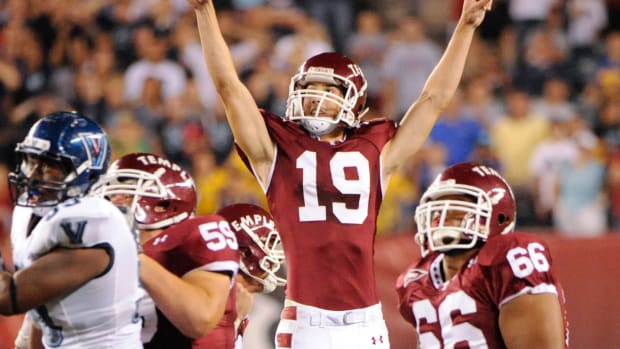Here's Why Broncos OC Pat Shurmur Must Call Heavier Personnel Packages Down the Stretch
One of the biggest issues with the Denver Broncos' offense is its propensity for abandoning the running game, especially when trailing on the scoreboard. Offensive coordinator Pat Shurmur's odd penchant for imbalance has been widely documented, statistically proven, and discussed all over Broncos Country for the past two seasons.
The combination of slow offensive starts and explosive scoring plays allowed by the Broncos' defense has accentuated that glaring problem this season, with games against Baltimore, Pittsburgh, and Cleveland as prime examples to look back on. It's incredibly frustrating to watch, especially considering the success the Broncos have had with Melvin Gordon and Javonte Williams leading the way on the ground.
Analyzing the game logs reveals that the Broncos' only enemy to the rushing offense is themselves. Both backs average over four yards per carry on the season, and Williams is among the league leaders in explosive runs as well as forced missed tackles.
Last week's performance against the Los Angeles Chargers was a great example of what happens when the Broncos' offense sticks to the running game. Even before securing a quick lead in the first quarter, Denver decided early that its best path to success was on the literal legs of the running game.
Denver ran the ball on 31 total designed plays for 137 yards, scoring two touchdowns (one on a Teddy Bridgewater scramble) and imposing its will against a Chargers team that has admittedly been the worst rushing defense in the league this season. But after rewatching the game, something popped even more than merely sticking with the run.
It was how the Broncos ran the ball — specifically, what offensive personnel was on the field. Personnel packages are typically designated by a two-digit number with the first digit representing the number of running backs in the formation, followed by the second digit representing the number of tight ends.
By now, everybody knows that Shurmur likes to line up in 11 personnel, or formations with one running back, one tight end, and three wide receivers to round out the rest of the formation. In fact, over the course of the season, Denver has lined up in 11 personnel on 60% of its offensive snaps. Against the Chargers, this trend was broken.
Late in the first quarter, Denver was forced to insert Drew Lock into the game due to Bridgewater being injured. After a nearly disastrous fumble by Lock a few plays later, Shurmer opted to go in a different direction and it was arguably the most effective the Broncos' rushing attack has been all season.
12, 13, & 22 Personnel
Following the fumble, Shurmur called five straight plays with three tight ends on the field, including Andrew Beck lined up as a full back on every play. While technically this would be considered 13 personnel because Beck is listed as a tight end, it was actually a 22 personnel look with two backs in the backfield and two tight ends attached at the line of scrimmage with a single receiver split out wide.
On those plays, Denver ran four times for a combined 35 yards, setting up a goal-to-go situation. On each of those plays, Beck made key blocks to help spring Williams and Gordon loose for chunk yardage. Denver would later score on a nine-yard run by Williams.
Later on the game-sealing drive, Denver was able to replicate the same success with its 12, 13, and 22 personnel by running the ball seven times for 32 yards to kill the clock prior to the kneel-down to end the game, with a variety of 2-RB sets combined with true 3-TE sets to open running lanes upfront.
It was one of the first times we've seen the Broncos successfully close out a game with their four-minute offense over the past several years.
Statistical Analysis
According to SharpFootballStats.com — a site that tracks offensive personnel groupings and frequency as well as the efficiency of them on a per-down and per-game basis — the Broncos operated out of 12 and 13 (or 22 based on alignment) personnel on 18 total plays, or 50% of their total offensive plays after the Lock fumble.
That also includes plays after Bridgewater re-entered the game in the third quarter. Of those 18 plays, the Broncos ran the ball 16 times for 60 yards with a success rate of 50% with a 4.8 yards-per-carry average.
While there is a caveat of playing with a large lead against the literal worst rushing defense in the league, this data, along with numbers provided over the course of the season, would suggest that running more 12 and 13 personnel looks — and more specifically using Beck as the fullback — would be a boon for the Broncos.
In fact, when the Broncos operate out of their 13 personnel package in the season-long statistics, their successful play rate is just shy of 50%, with splits of 42% in the running game and a whopping 75% in the passing game.
The sample size is small, but Denver is 9-of-12 passing for 124 yards and two touchdowns with a 147.2 passer rating. The Broncos have also rushed for a gaudy 4.8 yards per attempt over 43 total carries for 206 total yards and another pair of scores.
In 12 personnel, the Broncos are at their most efficient when running the ball. With a successful run rate of 51%, they're averaging 4.3 yards per rush on 88 total attempts. That totals 379 yards on the ground.
The Takeaway
Now, this doesn't mean that the Broncos need to drop their base package completely. After all, completely changing the identity of the offense this late into the season would be nearly impossible and perhaps ill-advised. But the efficiency statistics speak for themselves when the Broncos operate out of 12 and 13 personnel.
Using more of these packages down the stretch of the season would be a great idea, especially against the defensive lines they're going to play against. It's a long season and so it stands to reason that implementing heavier personnel groupings could only help in exploiting opposing defenses that are beginning to succumb to the attrition.
Breaking down the remainder of the schedule, the Broncos have two games against the Kansas City Chiefs (55% successful rushing rate allowed), one against the Detroit Lions (48%), one against the Cincinnati Bengals (46%), one at the Las Vegas Raiders (50%), and their final game against the Chargers (60%). Denver should really lean into its rushing attack.
As the offensive line gets more healthy and the calendar turns towards the end of the season (when running the ball becomes of higher importance), the Broncos need to utilize the most efficient aspect of their offense in order to make a strong push towards the playoffs.
It ain't rocket science.
Follow Lance on Twitter @SandersonMHH.
Follow Mile High Huddle on Twitter and Facebook.
Subscribe to Mile High Huddle on YouTube for daily Broncos live-stream podcasts!





